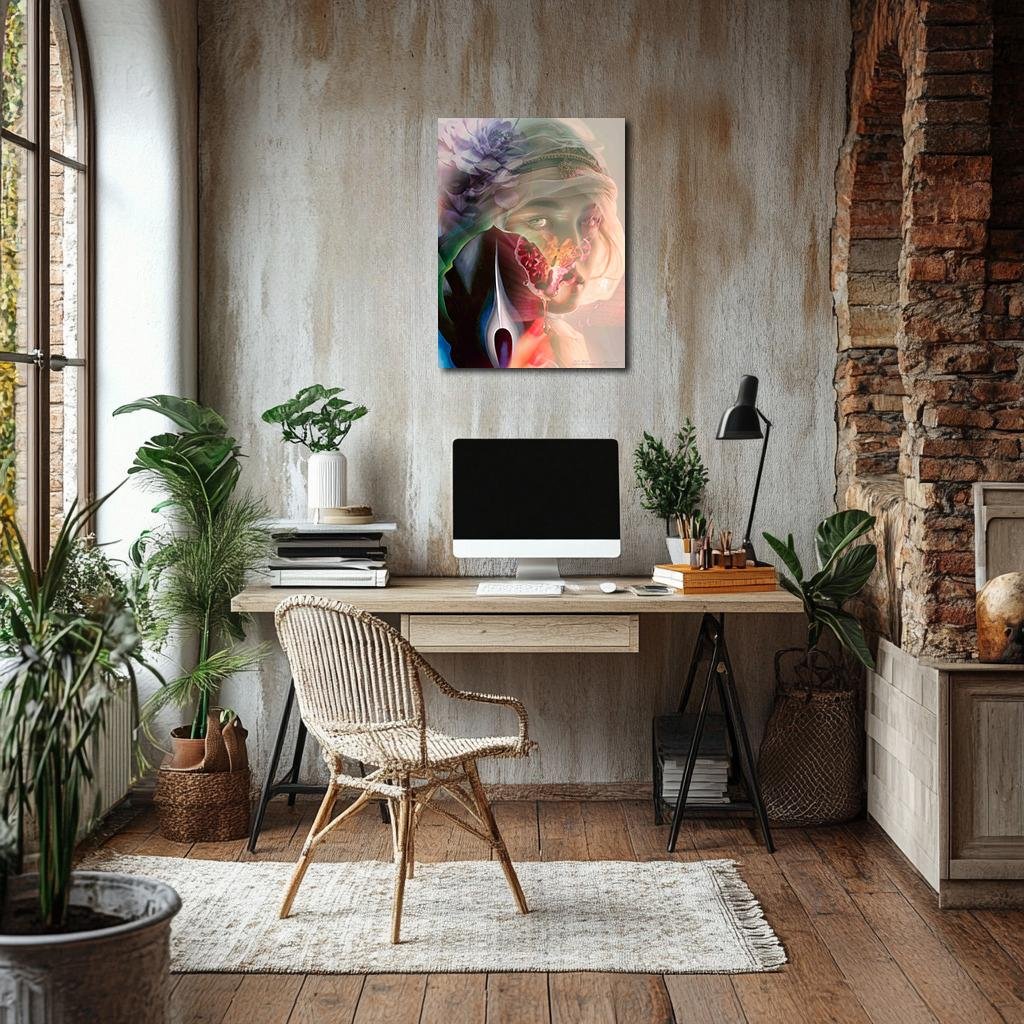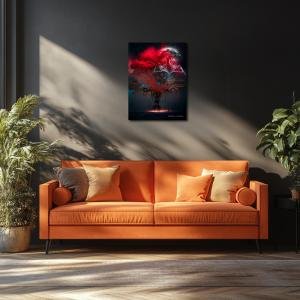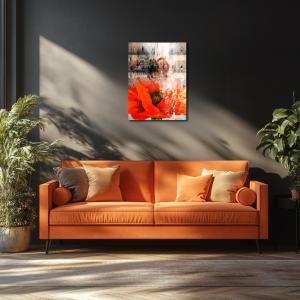Veil of the Pulpit: Echoes of O’Keeffe’s Bloom
Veil of the Pulpit reimagines O’Keeffe’s Jack-in-the-Pulpit No. IV as a sensual, symbolic portrait of veiled identity and inner voice. A delicate blossom flows into the face of a woman wrapped in translucent fabric, where petals become lips and silence becomes bloom. Saturated in rich emeralds, purples, and deep floral pinks, the image explores femininity as sacred space—both hidden and powerful. O’Keeffe’s flower transforms into a metaphor for language, desire, and emotional truth, becoming less a botanical study and more a living altar of voice, beauty, and the unseen spirit of blooming selfhood.
Please see Below for Details…
Hotline Order:
Mon - Fri: 07AM - 06PM
404-872-4663
Veil of the Pulpit is a dreamlike reconstruction of Georgia O’Keeffe’s Jack-in-the-Pulpit No. IV , fusing the sensuality of floral abstraction with the mystique of human identity. In this reinterpretation, O’Keeffe’s pulsing botanical form becomes not merely a study of nature, but a mask of emotion, delicately overlaid upon the face of a veiled woman—half-hidden, half-blooming. The organic folds of the flower, once an isolated study of plant anatomy, now bleed into the human skin, lips, and gaze, merging the biological with the spiritual. This symbolic union unearths a quiet power, suggesting how beauty, gender, and voice are veiled not only by fabric but by culture, longing, and silence.
The original Jack-in-the-Pulpit No. IV , painted in 1930, focused on the dramatic vertical throat of the flower. O’Keeffe's close-up abstraction turned a humble woodland bloom into an oracular presence—feminine, sensual, sacred. In this conceptual reimagining, that pulpit opens again, but not into nature—instead, it flows into the hidden depths of a woman's expression. The central column of the flower, its phallic and symbolic spine, is gently distorted into the shadow of a pen or spire, resting beside the curve of the woman’s lips, invoking not just femininity but articulation—the sacred act of speaking, writing, or being heard.
A delicate veil enshrouds the upper half of her face, catching soft glimmers of lavender and pale gold in its netting. This veil, transparent yet obscuring, suggests both protection and restraint—echoing how O’Keeffe’s own artistic voice emerged in a time when female sensuality and expression were cloaked in social modesty. Through this visual metaphor, the flower’s open throat becomes the artist’s own, daring to bloom in spite of silence.
The colors within this piece unfold like the petals of O’Keeffe’s original palette, but are enriched here with narrative intention. The deep emerald and black from the original flower’s outer sheath now form the contour shadow around the jaw and neck, hinting at strength beneath gentleness. These tones represent rootedness—earth, origin, the primal mystery of growth. Just beside them, a sweep of cool amethyst unfurls across the upper veil and cheekbone, offering an aura of serenity, introspection, and the sacred feminine. This purple does not demand—it whispers, inviting the viewer to enter the quiet power of being seen without performance.
The vivid fuchsia and crimson of the flower’s tongue press softly across the lips and cheek of the subject, suggesting not only eroticism but emotional saturation—passion held just beneath the surface. These tones are sensuous but never vulgar, alive with blood and blossom. A pale pink drip from the petal’s edge mimics a tear, highlighting the thin line between beauty and sorrow, voice and silence. This emotional ambiguity is key to the composition—it neither explains nor contains the feeling, but lets it exist fully and freely.
Behind the face, shadows shift—another figure, another face, a ghost of former identity perhaps, tinted in navy blue and muted violet. This echo reminds us of O’Keeffe’s lifelong wrestling between self and persona, the painted and the personal. The presence is barely there, but essential—like memory, like echo, like the unspoken parts of ourselves that linger in all expression.
The background is awash in a soft blend of sage green and warm ivory, evoking both nature and parchment—a garden and a manuscript. It acts as a gentle stage for the central bloom-figure, grounding the surreal overlays in O’Keeffe’s original meditative stillness. The overall composition remains intimate and vertical, like the original floral study, yet breathes now with layered consciousness—woman, flower, thought, memory, voice.
Veil of the Pulpit is not just a celebration of form—it is a conversation about identity. It reflects O’Keeffe’s capacity to find enormity in the smallest natural gesture, and here expands that gesture into the emotional territory of selfhood. The Jack-in-the-Pulpit is no longer just a flower—it is a vessel of voice, a visual psalm of feminine strength. It becomes both mask and mirror, hiding and revealing the sacred within.
When creating this reinterpretation, I considered how O’Keeffe’s refusal to name her work as sexual was itself an act of power—she painted without explanation. This composition embraces that ambiguity. It is sensual, but not in service to gaze. It is expressive, but not declarative. The veiled woman is not a portrait, but an energy—a flowering thought, a blooming emotion, a spirit that cannot be wholly translated. Her beauty is not in the features but in their suggestion, their emergence from within the flower, not apart from it.
Add your review
Your email address will not be published. Required fields are marked *
Please login to write review!
Looks like there are no reviews yet.








